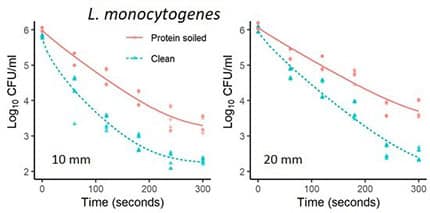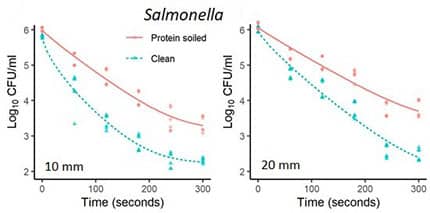Inactivation of Listeria monocytogenes and Salmonella on Stainless Steel
by a Piezoelectric Cold Atmospheric Plasma Generator
Abstract
The group of Alexandros Stratakos recently investigated the effect of piezoelectric cold atmospheric plasma on the foodborne pathogens L. monocytogenes and Salmonella on stainless steel surfaces.
Authors: Gonzalez-Gonzalez, C. R.; Hindle, B. J.; Saad, S. & Stratakos, A. C.
Publicaton: Inactivation of Listeria monocytogenes and Salmonella on Stainless Steel by a Piezoelectric Cold Atmospheric Plasma Generator, Applied Sciences, 2021, 11.
First published: https://www.mdpi.com/2076-3417/11/8/3567/html
Total Recap
In food processing, decontamination of the food contact surfaces is indispensable. One commonly used material in this context is stainless steel. I a recent work by the group of Alexandros Stratakos from the University of the West of England this issue was addressed by the use of piezoelectric cold atmospheric plasma.
For this investigation, stainless steel 304 plates were thoroughly cleaned and covered with the Gram-positive Listeria monocytogenes and Gram-negative Salmonella. Half of the samples were protein-soiled with Bovine serum albumin (BSA) to simulate real-life conditions. Cold atmospheric plasma was generated with the piezobrush® PZ2 from relyon plasma at distances of 10 mm and 20 mm. The log reduction up to a treatment time of 300 seconds were determined and fitted according to the Weibull + tail model.

The effect of cold atmospheric plasma is based on the reactive oxygen and nitrogen species (RONS), which act independently or in synergy through different mechanisms with the cell. One of the major effects is the oxidative damage of the membrane, structural proteins, and DNA, which ultimately lead to cell inactivation. The pathogenic bacteria covered with BSA experience a protective effect of serum albumin on the bacterial cells against the reactive species generated by the cold atmospheric plasma. Since the inactivation was tested on dried cells, no biofilms were allowed to form.

In this study the effect of cold atmospheric plasma on foodborne pathogens L. monocytogenes and Salmonella inoculated on stainless-steel was determined. The cold atmospheric plasma treatment was able to significantly reduce the levels of both pathogens. The log reduction is time dependent. Protein-soiled coupons showed a protective effect to cold plasma inactivation achieving lower reductions compared to clean stainless-steel coupons for both L. monocytogenes and Salmonella. Longer distances from the plasma source decreased the decontamination efficiency of CAP; however, the difference in pathogen reduction was less pronounced at longer exposure times.
Conclusion
This study demonstrates the capacity of cold atmospheric plasma device piezobrush® PZ2 to effectively reduce the levels of both foodborne pathogens on stainless-steel surfaces and the potential to adopt this technology by the food industry as a disinfection process of surfaces to reduce cross-contamination and thus increase safety.
Read the whole report here.




